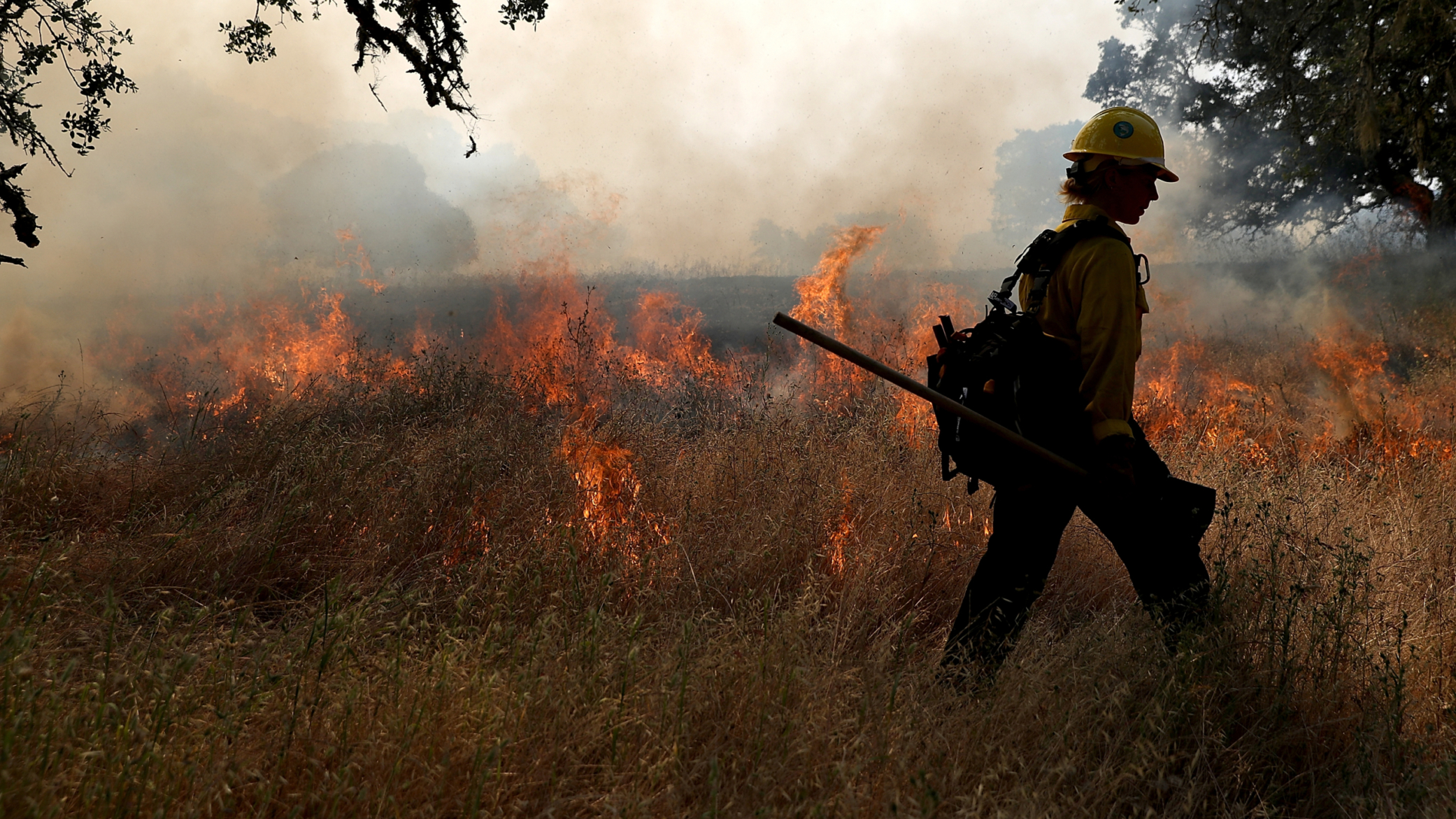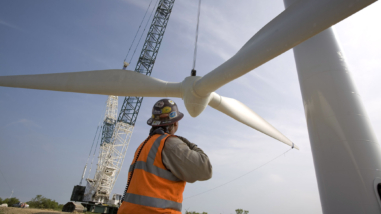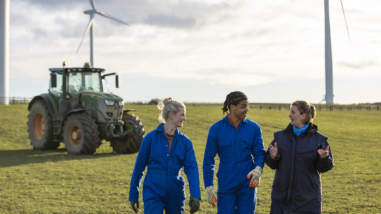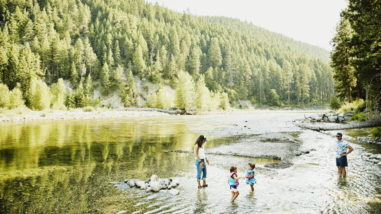Greater understanding of wildfires leads to better solutions

As a lifelong Californian, I’m no stranger to wildfire season. But these days, the season begins earlier in the summer, stretches later into winter, and contains record-breaking wildfire events year after year. This season, the Dixie Fire has already grown to be the second-largest wildfire in California’s history, and the Caldor Fire is threatening South Lake Tahoe. All while other large fires in California, Minnesota, Oregon, and Washington force evacuations throughout the drought-ridden West.
Many struggle with where to go for good wildfire information, especially as we seek answers on what we can do to get ahead of catastrophic events. As the only staff person in U.S. philanthropy working on wildfires full time, I immerse myself in wildfire resilience every day. Now in my third cycle of having wildfire stories overwhelm my inbox, I’ve been pleased to see that journalists are increasingly telling well-informed, science-based wildfire stories and interviewing experts to unpack the drivers of destructive wildfires and solutions for fire-resilient landscapes and fire-adapted communities. The bad news is I continue to see inaccuracies and misrepresentation of the science.
Understanding the wildfire problem
Fortunately, I have many wildfire experts in my network, including Hewlett grantees, who generously help me parse through the nuances of what it means to become more wildfire resilient. The 11 resources below offer a brief snapshot of the information available that has grown my own wildfire knowledge. I offer them to help with understanding the wildfire problem so that together, we can begin to address it.
Wildfires 101
California is up in smoke but still won’t stop playing with fire
News articles are increasingly reflecting more of the nuances of wildfire, but sometimes they misinform or only partially inform. This article in the San Francisco Chronicle pithily covers the many drivers of catastrophic wildfires and some accompanying solutions.
How years of fighting every wildfire helped fuel the Western megafires of today
The Conversation publishes articles written by academic experts and edited by a team of journalists. This article covers the results of a set of three studies published by 40 fire and forest ecologists examining the research on wildfires. One of these reviews science-based adaptation strategies for western North American forests and addresses ten common questions, including whether forest thinning and prescribed burning can solve the wildfire problem and whether proposed solutions can ever catch up with the scale of the problem.
Prescribed Burns: Fighting Fire with Fire
This video is a short introduction to prescribed burning produced by The Nature Conservancy in Montana. While every forest is different and therefore requires different management tools for wildfire resilience, this video explains the use of prescribed burns in forests where it makes sense.
‘Fire is Medicine’: The Tribes Burning California Forests to Save Them
An oldie but a goodie, this 2019 article highlights the work of Indigenous fire practitioners. It covers a lot of ground: a brief history lesson, what cultural burning looks like, the ecological and cultural importance of fire, and the incredible work people are doing to put more ‘good’ fire on the ground. Here’s a more recent article on Indigenous fire management, that’s also worth a read.
Going Deeper
Land Use Planning Approaches in the Wildland-Urban Interface
The majority of media coverage of wildfire resilience focuses on the landscape and rarely covers how communities are proactively adapting to wildfire. This report, supported by Hewlett Foundation funding, analyzes land use planning approaches in the wildland-urban interface of California, Colorado, Montana, and Washington. I also recommend these resources on defensible space and home hardening to learn about two foundational tools for reducing the wildfire risk of existing homes. See this article for a demonstration of what these two tools can do to protect a home.
California’s Wildfire and Forest Resilience Action Plan
The State of California’s Forest Management Task Force released this strategy in January 2021. I find it a useful document to better understand what it really takes to have fire-resilient landscapes and fire-adapted communities and how the most wildfire-battered state is trying to move forward The report, A New Strategy for Addressing the Wildfire Epidemic in California, takes a crack at estimating what it will cost the state to move toward fire-adapted communities and fire resilient landscapes.
This excellent report explores the legal and policy underpinnings of current barriers to expanding the scope of cultural burning and prescribed fire in California. It also outlines possible solutions. If you want to dig deep into prescribed burning, many of these barriers and solutions apply beyond the California context.
Wildfire Resilience Funding: Building Blocks for a Paradigm Shift
This report from The Nature Conservancy, which the Hewlett Foundation helped fund, is a first-of-its-kind analysis of existing federal funding streams and programs for wildfire resilience. It offers thoughtful recommendations for increased investments.
Staying Informed
The Fire Learning Network newsletter comes about twice a month and presents a great roundup of wildfire news and resources. It covers general news, funding opportunities, articles and reports, job postings, webinars, and trainings. It has a mix of information that’s easily digestible and information that gets into the weeds for those who want to geek out on wildfire science and practice. The newsletter often features articles published on the Fire Adapted Communities Learning Network blog, authored by fire practitioners. Subscribe to the newsletter read the latest issues here.
This podcast is new to me, but it comes highly recommended by a colleague. For those who want their fire information on-the-go, this podcast could prove a powerful resource.
This website provides balanced, science-based information on collaborative and realistic paths forward for fire adapted communities and fire resilience landscapes. In addition to thirteen digestible facts about forest fires and eight concrete solutions, this website cultivates a plethora of resources for those seeking additional information.
Supporting wildfire resilience
The resources outlined above have taught me that while communities devastated by wildfire will continue to need support as they grieve and figure out how to move forward, the funding community needs to shift from solely reactive support for community recovery after a fire event to the more complicated but long overdue support of fire-adapted communities and fire-resilient landscapes. That requires that we embrace real solutions, which include:
- Inclusive collaboration that goes beyond the wildfire and forest health communities to include those working at the intersections of health, water, climate, economic development, and the building and insurance industries;
- Investments to help communities adapt to the current wildfire realities via home hardening and defensible space and careful consideration of wildfire risk when planning future developments;
- Investments in fire resilient landscapes at scale, not just for wildfire resilience benefits, but all the other co-benefits that come with healthy landscapes—more robust carbon storage, watershed protection, improved wildlife habitat, and more;
- Elevating tribal stewardship and facilitating the use of prescribed burning combined with mechanical thinning where appropriate; and
- Increased investment not just from the government, which has committed significant resources to wildfire resilience in the past year, but also from the philanthropic and private sectors to match the scale of the problem.
A huge thank you to the many wildfire experts who sent me resource recommendations reflected in this list. These individuals, and many others, are doing incredible work to move us toward a more fire-resilient future.



